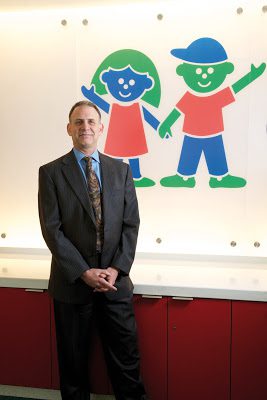Three years ago, Children’s Healthcare of Atlanta set a goal to expand its facilities and increase its staff from 5,600 to 8,000 employees to compensate for the organization’s growing nursing, administrative and physician sectors. While seeking additional talent, executives also hoped to fix a snag in the organization’s succession initiatives.
At the time, the hospital was able to hire less than half of its vacant managerial positions using internal succession planning. However, in the past five years, the organization’s Center for Leadership Strategies, led by Vice President and Chief Learning Officer Larry Mohl, has helped it to hire 65 percent of its leaders internally, bringing the count for internal employees to more than 8,500 in 2010.
With more than half a million annual patient visits in 2010, Children’s Healthcare of Atlanta is the country’s largest pediatric health care provider. Mohl’s work at the helm of the hospital’s continuing medical and leadership education program helps staff to stay abreast of advances in clinical care within the expanding organization and industry.
Engineering Development: Creating Roles and Leaders
Mohl’s formal education shaped him to become an engineer. After receiving his bachelor’s degree in electrical engineering from the University of Buffalo and master’s in biomedical engineering from the University of Michigan, he began working for Motorola as an engineer in research and development. As he moved to similar roles in product development and product management, he said he recognized a lack of satisfaction with his responsibilities.
“My passion was more with people than with things,” he said. “I was very interested in how people were doing things together. Within my own group of engineers, I was coming up with new ways of having people learn things as we developed new products, implemented products and worked with customers.”
While Mohl trained his fellow engineers and was given the opportunity to establish his own internal consulting group, Motorola was creating and executing Six Sigma, a business management strategy it developed in 1986 to improve the quality of process outputs by identifying and removing the causes of defects and minimizing variability in business processes.
Mohl moved his traditional coursework approach to training engineers to an application approach where employees would learn something related to Six Sigma and then have to go to their job and apply it successfully before learning more. As the role he had created for himself grew, so did his responsibilities and number of direct reports.
“I started to get myself trained in areas around human capital, leadership development, organizational learning, behavioral change and other things that would round out what I needed to help people do well by getting resources to make sure they made the changes we needed to make the organization better,” Mohl said. “At the same time, I got some training and facilitation skills, consulting skills and did a year at an improvisational theater training center so I could really get better at being in front of people.”
Motorola quickly acknowledged that engineering knowledge was moving fast and that all of the company’s technicians would be outdated if not trained regularly. Mohl took a role as director of knowledge management within Motorola University, where he worked to implement communities of practice to help facilitate the flow of knowledge around the organization and address the lack of development options for engineers.
Mohl later took on the role of director of leadership, learning and performance to lead Motorola’s personal communications sector. He was responsible for leadership supply and competency development and managed more than 40 employees worldwide for three years before being approached by American Express to become the company’s chief learning officer. Mohl accepted the position and was a member of the global talent senior leadership team for two years before feeling another urge to change his career path.
“Suddenly I was looking to get closer to something a little bit more mission based,” he said. “I wanted to take everything that I had learned at Motorola and AMEX and apply it to health care. My background in bioengineering allowed me to always be around and familiar with health care in the past, and I wanted to contribute there.”
Introduction to Health Care: Sharing and Learning
Children’s Healthcare of Atlanta hired Mohl to create and run its Center for Leadership, which began as an executive-level experience.
“We still have that today — it’s called The Executive Experience — but Larry also developed a curriculum for high-potential managers that we want to groom to move into leadership, as well as a foundations program for supervisors and first-line managers we want to develop to meet growing demands,” said Linda Matzigkeit, senior vice president of strategic planning and human resources at Children’s Healthcare of Atlanta. “Larry has been instrumental in building these three programs that all fall under the umbrella of the Center for Leadership.”
The Center for Leadership brings together high-level managers from the system’s physician, nursing and administrative sectors. Over an 18-month, part-time period, nominated managers participate in workshops and share best practices from their departments to develop projects that address challenges in the organization and industry.
“We don’t consider this a training thing; we call them experiences,” Mohl said. “It’s part classroom workshop, there’s application on the job, there’s coaching that goes along with it, mentoring and actual application projects that participants need to do.”
Executive leaders within the organization, including Mohl and Matzigkeit, teach workshop courses alongside externally hired content experts. Since the program began, both the content and strategy in content delivery have remained unchanged due to visible benefits in individual employee growth as well as the Children’s board’s continuing approval.
To establish the program five years ago, the board began funding the Center for Leadership with endowment funds — a strategic move it believed would help build the organization’s future. As part of the endowment, Mohl and Matzigkeit made a commitment to the board to deliver positive results annually for five years before receiving the funding permanently.
Surveys measuring the leadership development program’s business impact were conducted yearly to determine the level of achievement and benefit participants received. Mohl worked with Robert O. Brinkerhoff, author of The Success Case Method, to create case studies with metric results for classes that would go through the program to both improve the learning and document the program benefits for the board. Continual success enabled the program to receive permanent funding last year.
As a part of the human resources team, Mohl is responsible for leadership and development, organizational effectiveness, clinical staff development, continuing physician education and technology training for all sectors of Children’s. As the head of strategy for the organization, Matzigkeit works with him to establish the company’s direction and to implement a learning strategy to build the company’s capability to reach established goals.
“Now we are all talking in a common language around strategy, financial principles, building capability and leading change,” Matzigkeit said. “We have tools and templates that employees receive in class that we see them using on the job. Using the same language, tools and processes has not only helped get everyone on the same page; it’s been a great development opportunity for our leaders who hadn’t had this kind of learning experience before.”
Learning for the People
Six years ago, Mohl’s team approached employees with an “employee promise” concept where they asked employees what they wanted from Children’s in order to recognize it as the best place to work. Employees identified four things that were most important for them to give their best: mutual respect, learning, work-life balance and total rewards.
“We told employees that our shared philosophy on learning and development is an important thing, and we’re going to make it available for you so you can grow yourself, your career and take care of the kids,” Mohl said. “We have a people strategy — to integrate everything together so you can make more efficient processes for people and get the data you need to make really good strategic business decisions.”
To successfully measure the benefits of learning initiatives, Mohl uses surveys, such as the one created for the Center of Leadership, and also tests physicians on skills, such as performing vaccinations, to guarantee their proficiency before allowing them to work with children. In order to test the impact of programs that teach these skills, Mohl created a simple measurement strategy to be used throughout the organization.
“The structure has three levels, and it’s like a triangle: all three factors need to be in place,” Mohl said. “Is the program working? Are people behaving differently because of what we did? Do we get some business impact from that?”
Mohl said he believes the enthusiasm employees displayed when positively answering those questions, along with the executives’ eagerness to grow learning, is what has fostered success within the company as well as a stronger client bond.
“I’ve rarely been in a place where I’ve felt more supported than at Children’s,” Mohl said. “When I first came, the CEO was very, very invested in learning. It was very unusual for health care to even have a CLO title at the time, so you could see how forward thinking the organization was about this.
“Our new CEO, Donna Hyland, fundamentally believes that we need to be improving, learning and developing. I like to tell people that at Children’s we have a healthy dissatisfaction for the way things are. All you have to do is walk through one of our hospitals and see these kids and how brave they are and what they’ve been through, and it just makes you want to do better and want to do more.”
Ladan Nikravan is associate editor at Chief Learning Officer magazine. She can be reached at lnikravan@clomedia.com.

















